Gigantic Unfinished Stone Structures Cut With Amazing Stone-Working Techniques
A. Sutherland - AncientPages.com - The Yangshan Quarry is famous for an unfinished stele of huge size that was abandoned there during the reign of the Yongle Emperor, the third ruler of the Ming Dynasty in China, reigning from 1402 to 1424.
The Yangshan Quarry, an ancient stone quarry near Nanjing, China, was used during many centuries as a source of stone for buildings and monuments of Nanjing. It is now preserved as a historic site.
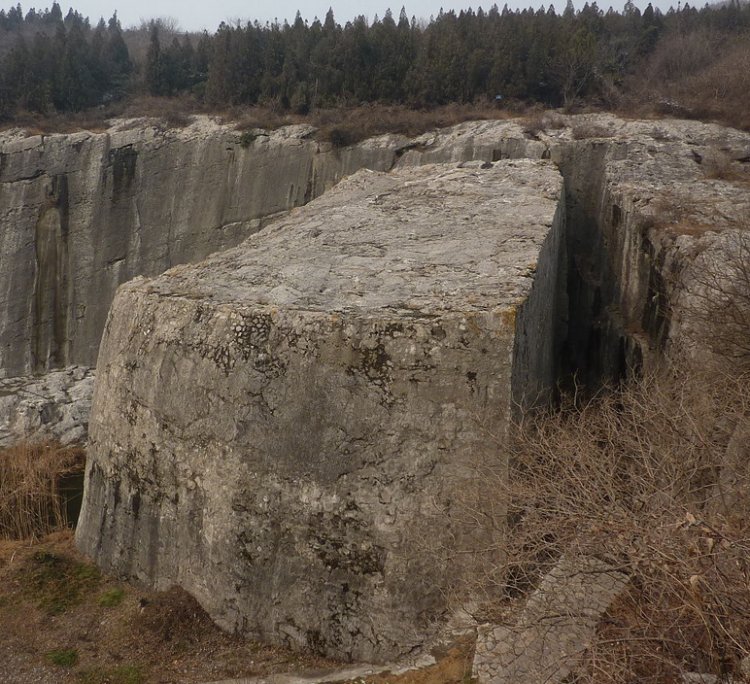
Yangshan unfinished stele, China -The stele base, partly separated from the body of the mountain. Photo: Wikipedia
In 1405, the Yongle Emperor, ordered the cutting of a giant stele in this quarry, for use in the Ming Xiaoling Mausoleum of his deceased father.
Three separate pieces were being cut: the rectangular stele base (pedestal), the stele body, and the stele head (crown, to be decorated with a dragon design). After most of the stone-cutting work had been done, the architects realized that moving stones from the quarry to Ming Xiaoling and installing them there in a proper way, would not be physically possible.
As a result, the project was abandoned and the three unfinished stele components remain in Yangshan Quarry to this day.
The present dimensions and the usual weight estimates of the steles are as follows:
The Stele Base is 30.35 m long, 13 m thick, 16 m tall, and weighs 16,250 metric tons. Its body is 49.4 m long, 10.7 m wide, 4.4 m thick and weighs 8,799 tons. The stele's head is 10.7 m tall, 20.3 m wide, 8.4 m thick and weighs 6,118 tons.
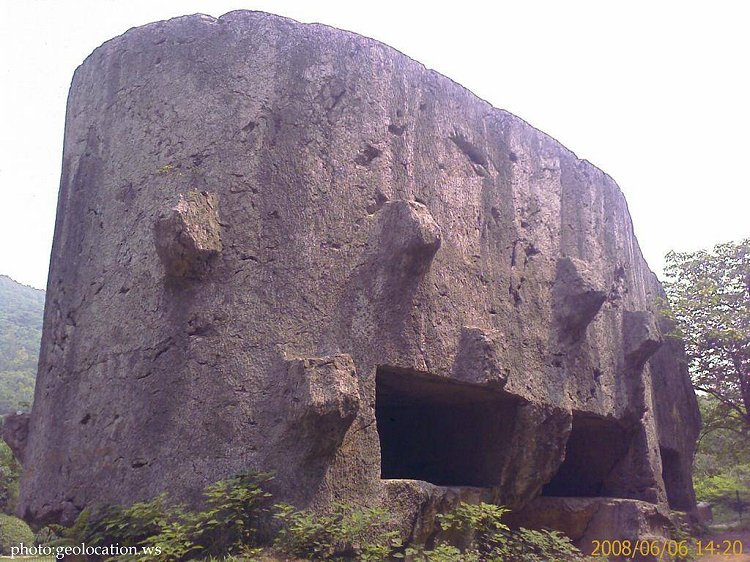
The unfinished "Monument Head" (image above) and the side of the Monument Body sitting still attached to the living rock in the middle of the north-eastern pit of the Yangshan Quarry, now nicely landscaped. The "head" is the top part of the stele, which, in a finished stele would probably have been fashioned into a dragon design.
According to experts, if the stele had been finished and put together, by installing the stele body vertically on the base, and topping with the stele head, then it would have stood 73 meters tall.
Legend has it that workers who failed to produce the daily quota of crushed rock of at least 33 sheng would be executed on the spot.
In memory of the workers who died on the construction site-including those who died from overwork and disease-a nearby village became known as Fentou, or "Grave Mound".
Today, the place is also called "Death's Head Valley".
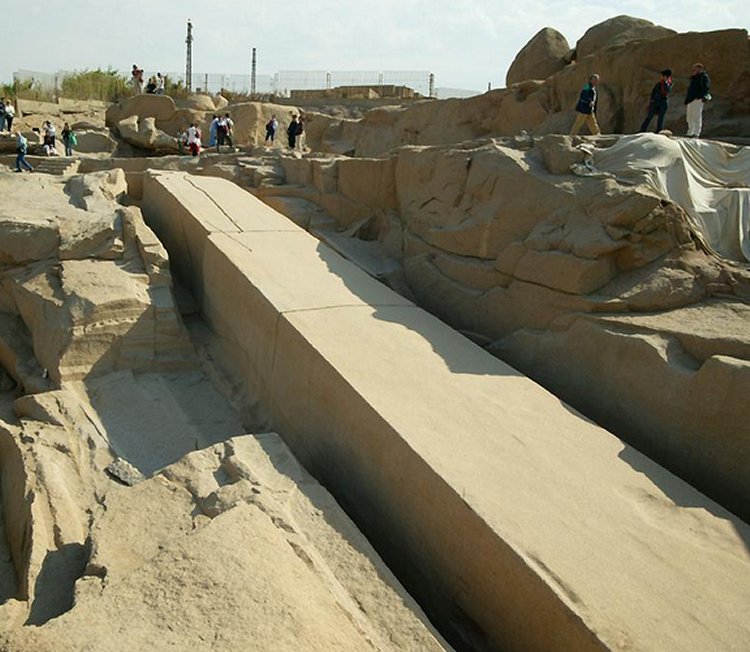
The obelisk's creators began to carve it directly out of bedrock, but cracks appeared in the granite and the project was abandoned. Originally it was thought that the stone had an undetected flaw but it is also possible that the quarrying process allowed the cracking to develop by releasing the stress. The bottom side of the obelisk is still attached to the bedrock. (via clubvision-eg)
Another unfinished gigantic stone structure is located in the northern region of the stone quarries of ancient Egypt in Aswan (Assuan), Egypt. It was ordered by Hatshepsut (1508–1458 BC), possibly to complement the Lateran Obelisk (originally at Karnak, and later brought to the Lateran Palace in Rome).
It is nearly one third larger than any ancient Egyptian obelisk ever erected. If finished it would have measured around 42 m (approximately 137 feet) and would have weighed nearly 1,200 tons.
The unfinished obelisk offers unusual insights into ancient Egyptian stone-working techniques, with marks from workers' tools still clearly visible as well as ocher-colored lines marking where they were working.
At the southern entrance of Baalbeck is a quarry where the stones used in the temples were cut. A huge block, considered the largest hewn stone in the world (another ancient stone block is also nearby) still sits where it was cut almost 2,000 years ago.
Called the "Stone of the Pregnant Woman", it is 21.5m x 4.8m x 4.2meters in size and weighs an estimated 1,000 tons. Similar stone blocks of a 20m-length were used for the podium of the huge Temple of Jupiter in the Roman sanctuary of Baalbeck.
Written by – A. Sutherland - AncientPages.com Senior Staff Writer
Copyright © AncientPages.com All rights reserved. This material may not be published, broadcast, rewritten or redistributed in whole or part without the express written permission of AncientPages.com
Expand for referencesReferences:
More From Ancient Pages
-
 Map Of Hidden NT Landscape Where First Australians Lived More Than 60,000 Years Ago
Archaeology | May 5, 2023
Map Of Hidden NT Landscape Where First Australians Lived More Than 60,000 Years Ago
Archaeology | May 5, 2023 -
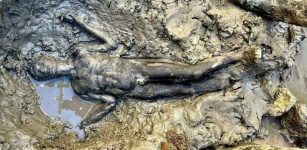 Well-Preserved Bronze Statues Discovered In Thermal Baths In Tuscany
Archaeology | Nov 11, 2022
Well-Preserved Bronze Statues Discovered In Thermal Baths In Tuscany
Archaeology | Nov 11, 2022 -
 Powerful Chola Rulers Of Southern India: Patrons Of Architecture, Art And Literature
Civilizations | May 4, 2017
Powerful Chola Rulers Of Southern India: Patrons Of Architecture, Art And Literature
Civilizations | May 4, 2017 -
 Unique Bronze Age Fortress Discovered In Galway, Ireland
Archaeology | Jun 25, 2022
Unique Bronze Age Fortress Discovered In Galway, Ireland
Archaeology | Jun 25, 2022 -
 On This Day In History: Edgar Allan Poe Known For Tales Of Mystery And Macabre Was Born – On Jan 19, 1809
News | Jan 19, 2017
On This Day In History: Edgar Allan Poe Known For Tales Of Mystery And Macabre Was Born – On Jan 19, 1809
News | Jan 19, 2017 -
 Did The Great Sphinx Of Giza Have A Twin And Was It Destroyed By A Lightning Strike?
Featured Stories | Dec 23, 2017
Did The Great Sphinx Of Giza Have A Twin And Was It Destroyed By A Lightning Strike?
Featured Stories | Dec 23, 2017 -
 Magnificent Solar Alignment Phenomenon In Abu Simbel – The Sun Illuminates The Face Of Pharaoh Ramses II
Featured Stories | Nov 11, 2020
Magnificent Solar Alignment Phenomenon In Abu Simbel – The Sun Illuminates The Face Of Pharaoh Ramses II
Featured Stories | Nov 11, 2020 -
 Ancient Quest For Mechanical Life: Humanoid Robots Of Our Ancestors
Ancient Technology | Apr 26, 2019
Ancient Quest For Mechanical Life: Humanoid Robots Of Our Ancestors
Ancient Technology | Apr 26, 2019 -
 3,000-Year-Old Fortress Built By The Mysterious Votadini Tribe Discovered On Top Of Arthur’s Seat
Archaeology | Sep 11, 2020
3,000-Year-Old Fortress Built By The Mysterious Votadini Tribe Discovered On Top Of Arthur’s Seat
Archaeology | Sep 11, 2020 -
 Secrets Of The Chephren Pyramid And Its Unknown Mysterious Force
Featured Stories | Mar 20, 2015
Secrets Of The Chephren Pyramid And Its Unknown Mysterious Force
Featured Stories | Mar 20, 2015 -
 Mysterious 2,000-Year-Old Disco Colgante – Unknown High-Tech Device, Representation Of A Spiral Galaxy Or Something Else?
Artifacts | Nov 20, 2020
Mysterious 2,000-Year-Old Disco Colgante – Unknown High-Tech Device, Representation Of A Spiral Galaxy Or Something Else?
Artifacts | Nov 20, 2020 -
 Ancient Maya Destroyed Their Environment 2,000 Years Ago – Effects Are Still Visible Today
Civilizations | Sep 9, 2015
Ancient Maya Destroyed Their Environment 2,000 Years Ago – Effects Are Still Visible Today
Civilizations | Sep 9, 2015 -
 Aboriginal Myth Of Kinrara’s Eruption 7,000 Years Ago Confirmed True By Modern Science
Archaeology | May 14, 2017
Aboriginal Myth Of Kinrara’s Eruption 7,000 Years Ago Confirmed True By Modern Science
Archaeology | May 14, 2017 -
 Well-Preserved 7,300-Year-Old Wooden Cabins Discovered In La Draga
Archaeology | Oct 23, 2023
Well-Preserved 7,300-Year-Old Wooden Cabins Discovered In La Draga
Archaeology | Oct 23, 2023 -
 Evidence Of Early Human Habitats Linked To Past Climate Shifts Discovered By Scientists
Archaeology | Apr 13, 2022
Evidence Of Early Human Habitats Linked To Past Climate Shifts Discovered By Scientists
Archaeology | Apr 13, 2022 -
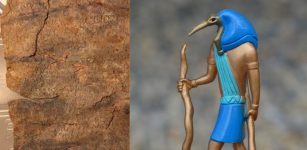 Curse Of The Dancer – Mysterious 1,500-Year-Old Tablet Finally Deciphered
Archaeology | Oct 14, 2019
Curse Of The Dancer – Mysterious 1,500-Year-Old Tablet Finally Deciphered
Archaeology | Oct 14, 2019 -
 Mesoamerican Rubber Ball Game Tradition Existed Earlier Than Thought
Ancient Traditions And Customs | Mar 17, 2020
Mesoamerican Rubber Ball Game Tradition Existed Earlier Than Thought
Ancient Traditions And Customs | Mar 17, 2020 -
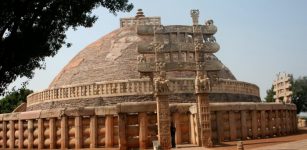 The Great Stupa At Sanchi – Oldest Stone Structure In India
Featured Stories | Dec 27, 2015
The Great Stupa At Sanchi – Oldest Stone Structure In India
Featured Stories | Dec 27, 2015 -
 Why Has Only One Such Puzzling Ancient Object Been Found In Norway?
Artifacts | May 4, 2018
Why Has Only One Such Puzzling Ancient Object Been Found In Norway?
Artifacts | May 4, 2018 -
 Emperor Kublai Khan: One Of The Most Powerful People In Human History
Featured Stories | May 23, 2017
Emperor Kublai Khan: One Of The Most Powerful People In Human History
Featured Stories | May 23, 2017

